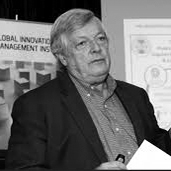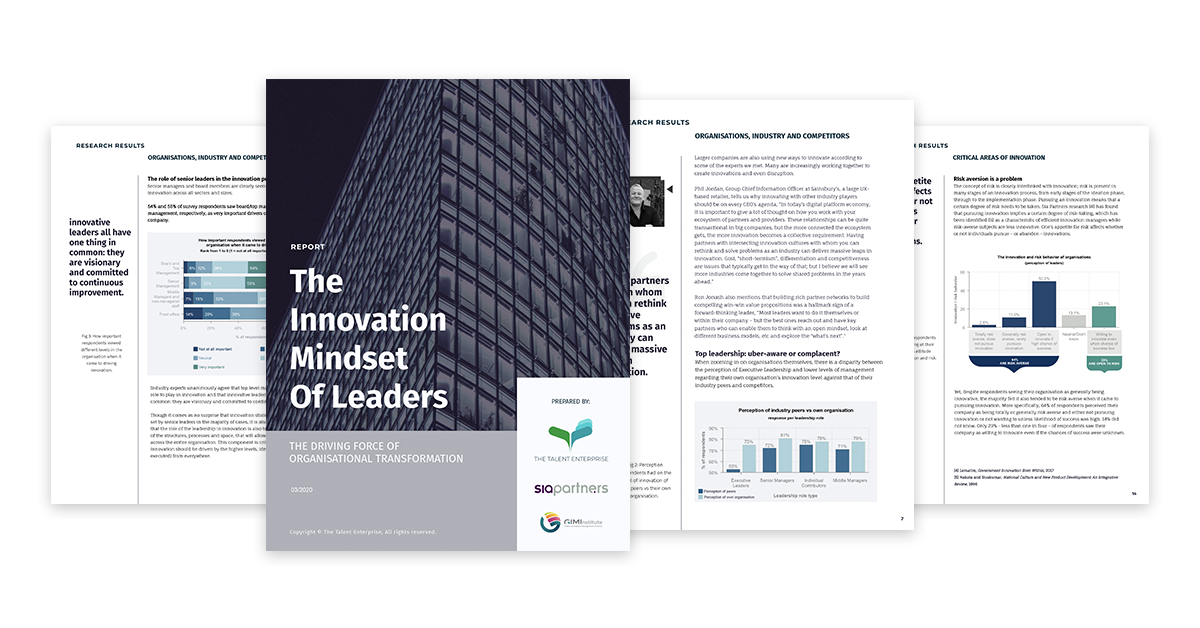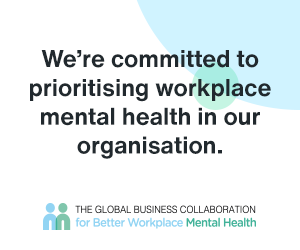As part of our research on “The Innovation Mindset of Leaders“, we conducted a series of interviews with high profile experts in the field to better understand what kind of leadership is needed for an organisation to stay ahead of the curve in today’s rapidly changing economy.
What do innovative leaders have in common? What are the organisational barriers to innovation? How do you future-proof an organisation? More importantly, why is it so hard? These are just some of the questions that sprung to mind when interviewing these thought leaders.
Our first expert is Prof. Ronald Jonash, Chairman of the Board of the Global Innovation Management Institute. His years of experience advising organisations on the topic of innovation and being Professor of Technology Strategy and Innovation at Tufts University Graduate School of Engineering, make him a fountain of knowledge and we hope you enjoy reading his insight.
How do you define innovation in an organisational setting?
It is important to note that having a lot of high performing individual innovators in an organization does not necessarily make that organization highly innovative.
We define organizational innovation as “the creation AND capture of new values in new ways – through new offerings, experiences, technologies, channels or business models – across the extended enterprise including customers, channels, suppliers and partners.”
This broad definition requires a focus on at least three critical elements:
1. Growth & innovation strategy: This is different from business strategy. It is focused on the “why” and “when” as much as on the “where” and “what”. It connects future with present, things beyond your business with things within your business: it’s a connective tissue. Leading companies usually have their top senior leadership team come up with this strategy and it then cascades down to their different departments and businesses. Its critical elements are what we call “I cubed”: information, intelligence and insights.
2. Innovation capacity and activation: The capacity to innovate across disciplines, silos and businesses, through individuals, teams and networks is key. However, many organisations improve capacity but don’t activate it – you can have a lot of really innovative people, but if they don’t feel like they are being encouraged, if they are not complying to what they are being asked to do, if the metrics aren’t aligned, you can’t activate this capacity.
3. Innovation discipline: This is exercised through processes and organizations and supported by aligned metrics, culture, behavior and mindset as well as the rewards and recognition. As an example, we, in general, are not in favor of an innovation department with a Chief Innovation Officer unless they have the power and freedom to work across businesses and departments. They can’t work well if they work in a separate silo, it has to be a network. The discipline aspect enables organisations to manage their people so they feel they are part of the company’s innovation mission to be successful in present and future.
What do innovative organizations and their leaders have in common?
They think AND act with an open innovation mindset to address key insights and intel related to “what’s next” and “what if”, not just “what is”. They walk the talk in terms of both mindset and behavior. They also have a clear commitment to change, innovation, as well as to being a leader today and 5 years from now. They tend to focus on these three key drivers of success:
1. The development and leveraging of rich networks and partners to build compelling win-win value propositions and robust business cases. Most leaders want to do it themselves or within their company – but the best ones reach out and have key partners who can enable them to think with an open mindset, look at different business models, etc and explore the “what’s next”.
2. The creation of powerful and flexible teams and sprint mentalities/processes to drive bigger, better, bolder, cheaper and faster 10X solutions to growth and innovation challenges.
3. The balance of driving both current performance and future potential. Many CEOs will say “there is not future without a present”, and that’s true, but the best leaders know that the opposite is just as true: there is no present without a future. If you don’t have a future, your best clients, employees, leaders and partners will leave. You have to balance driving current performance AND you building the future. How well you do today is critical but the value of your company is also largely based on the foundation you build for the future.
What are the top things a senior management team can do to create an innovation culture?
Again, walking the talk is so important – if the senior team cannot do that, their innovation objectives will just be viewed as the flavor of the month. Some of the signaling mechanisms they can use include:
– Holding regular detailed reviews of innovation strategy and performance and have a cross functional Chief Innovation Officer as a permanent member of the senior management team.
– Making sure metrics, reward and recognition mechanisms are aligned to the kind of innovation results and behaviors you want because it’s behavior that will drive culture.
– Building diverse teams and talents that use a common innovation language and tools that are best suited to driving business success in a rapidly changing world.
What are the biggest barriers to innovation? How can they be overcome?
Barriers which come up all the time are resistance to change and complacency. If you are doing fairly well, or if you aren’t going bankrupt yet, then you figure “I don’t need to do anything different on my watch. I can kick the can down the road and the next person can deal with it.” Fear of failure and closed mindedness are also common issues that hinder innovation.
Here are some ways to combat these: Complacency is best offset by developing convincing future scenarios and story lines where the contrary mantra becomes “Innovate or Die”. Fear of failure can be offset by the identification of new opportunities to grow with new assets, and where the counter winning strategy is “New Partners, New Moves”. Closed mindedness, ie. “I like working with people and ideas I know”, can be overcome by a continuing commitment to diversity of thought which drives open innovation and open mindedness from within the organization to the “extended enterprise” and beyond.
All these barriers be overcome by countermeasures that support the urgency of flexibility to change and preparing for the future.
How can organizations ensure they are “innovation-ready?
It really goes back to the three critical components of innovation mentioned previously. Companies always have to continuously pressure test their strategy and capacity against different scenarios and emerging changes in the market while also having innovation discipline in place to keep innovation alive. In the strategy arena, they should have a wide “I cubed” (information, intelligence and insights) as opposed to having a traditional intel operation that just provides them with information. They need to drive for insights that will change behavior.
They also need a pipeline of “real options” and opportunities to build high value “growth and innovation platforms” that can be altered quickly if necessary. Capacity is also very important. Even if it isn’t activated, you need capacity and it can’t be built overnight, it has to be in place. So leaders must ensure they have capacity that can be rapidly activated and deployed in sprint teams and new business development teams experienced in working together who can take the lead, rapidly develop and exploit new business innovation opportunities to convert them into real and sustainable growth platforms. We are really big on the fact that innovation is a team sport, it cannot depend on a group of individuals.
Finally, you must have innovation discipline set up through a foundation of well-developed metrics, innovation behavior drivers and organisational alignment. It is also key that leaders always follow through with what they say, so the day something is mission-critical, they will get all hands on deck.
In your opinion, what can be done in a company’s recruitment and employee development process to ensure an organization has the people it needs to become/stay innovative?
Forward thinking recruitment and employee development programs and policies are absolutely critical to a sustainable high performing innovation organization. Three of the most important categories in this arena are:
1. Recruiting for excellence AND diversity in individual hires and partners to assure a robust and accessible network of high-performance innovation team members who are open-minded and skilled in the diverse skills required for success in the innovation arena
2. Leadership development programs that stress the importance of both discipline and flexibility in experiential learning on teams to develop winning solutions and new growth and innovation platforms for now and the future.
3. Human resource programs that celebrate success as well as learn rapidly from failures to build a truly innovative learning organization prepared for the uncertainties of the future.

Prof. Ronald Jonash
Chairman of the Board
Global Innovation Management Institute







